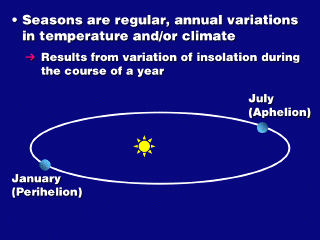 We observe that temperatures vary in a set pattern over the year. This pattern
is translated into seasons. We figure that the seasonal changes must be due
to regular changes in insolation, given the variation of temperature being the
most prominent feature of the changes.
We observe that temperatures vary in a set pattern over the year. This pattern
is translated into seasons. We figure that the seasonal changes must be due
to regular changes in insolation, given the variation of temperature being the
most prominent feature of the changes.
So what causes the regular changes
in insolation? We know that the Earth's orbit around the sun is elliptical,
and sun is off-center; thus, the sun-earth distance varies during the year.
By the inverse square law
(the greater the distance from a point source of radiation, the lower the intensity),
the Earth should be warmer at Perihelion (Earth closest to the sun) in
January and cooler at Aphelion (Earth farthest from the sun) in July.
Well, this may be true for the Earth as a whole, but we know that in the Northern
Hemisphere, it's winter in January, when the Earth is closest to the sun, and
summer in July. In addition, the difference in the distances at Perihelion and
Aphelion is about 3-4% (147 vs. 152 million kilometers), which affects the overall
Earth temperature minimally, if at all. So it's not the Earth-sun distance change
that causes the seasons. . .



 We observe that temperatures vary in a set pattern over the year. This pattern
is translated into seasons. We figure that the seasonal changes must be due
to regular changes in insolation, given the variation of temperature being the
most prominent feature of the changes.
We observe that temperatures vary in a set pattern over the year. This pattern
is translated into seasons. We figure that the seasonal changes must be due
to regular changes in insolation, given the variation of temperature being the
most prominent feature of the changes.